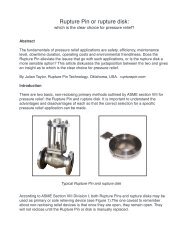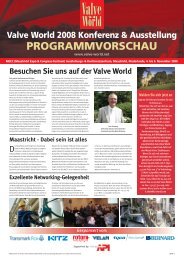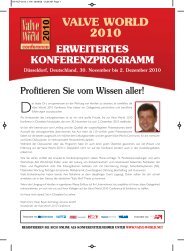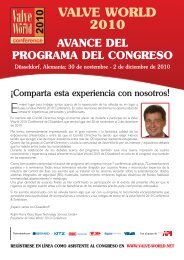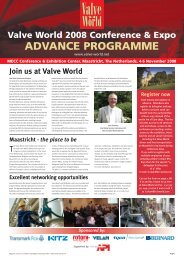Nickel-Aluminium Bronze for Seawater: Flattered by ... - Valve World
Nickel-Aluminium Bronze for Seawater: Flattered by ... - Valve World
Nickel-Aluminium Bronze for Seawater: Flattered by ... - Valve World
Create successful ePaper yourself
Turn your PDF publications into a flip-book with our unique Google optimized e-Paper software.
advised <strong>for</strong> duplex materials (Smith et al, 2000; Norsok M-001, Aramco SAES-L-105).<br />
In general, NAB is good in acidic environments, but as strongly alkaline environments remove the<br />
protective film, corrosion rates in this case can be high.<br />
4.7 Corrosion summary<br />
Building on earlier work (Oldfield and Masters, 1996), the tables in Figs 5a and 5b are a summary<br />
of the relative corrosion of the materials considered. The scale is arbitrary and intended to convey<br />
the overall per<strong>for</strong>mance of the various materials under the appropriate headings. It is useful if the<br />
scale is used as intended: a ranking system, rather than a detailed comparison (10 does not mean<br />
twice as good as 5). Columns <strong>for</strong> wear and galling per<strong>for</strong>mance have been added. The excellent<br />
NAB properties in this area make the life of valve designers and users significantly easier.<br />
Rather than identify an overall winner, the strengths and weaknesses of the various materials are<br />
identified. None of these properties can be properly considered without a view of the costs and<br />
intended life as well.<br />
Arbitrary scale,<br />
higher is better<br />
General<br />
Corrosion<br />
Pitting<br />
Corrosion<br />
Crevice<br />
Corrosion<br />
Erosion<br />
Corrosion<br />
Cavitation Stress<br />
Corrosion<br />
<strong>Bronze</strong> 8 9 9 7 5<br />
NiAlBrnze 9 10 8 8 8 10<br />
Ni-Cu Alloy 10 5 2 10 8 ?<br />
Carbon 3 3 2<br />
Stainless 10 4 3 10 7 8<br />
6Mo 10 9 8 10 8 8<br />
Duplex 10 5 4 10 8 9<br />
Superduplex 10 9 8 10 8 9<br />
Ni Alloy 625 10 13 12 13<br />
Ni Alloy C22 10 14 10<br />
Titanium 10 15 10 9<br />
Figure 5a: Comparative corrosion per<strong>for</strong>mance, part 1 (after Oldfield and Masters, 1996)<br />
Arbitrary scale,<br />
higher is better<br />
Polluted<br />
<strong>Seawater</strong><br />
Corrosion<br />
Fatigue<br />
Fouling<br />
Resistance<br />
Galvanic Wear &<br />
Galling<br />
<strong>Bronze</strong> 10 5 10<br />
NiAlBrnze 4 9 8 6 10<br />
Ni-Cu Alloy ? ? 4 8 5<br />
Carbon 1 8<br />
Stainless 4 6 1 4/7 6<br />
6Mo 9 6 1 9 5<br />
Duplex 5 9 1 8 4<br />
Superduplex 9 9 1 10 3<br />
Ni Alloy 625 12 1 10 3<br />
Ni Alloy C22 1 10 3<br />
Titanium 1 9 2<br />
Figure 5b: Comparative corrosion per<strong>for</strong>mance, part 2 (after Oldfield and Masters, 1996)



